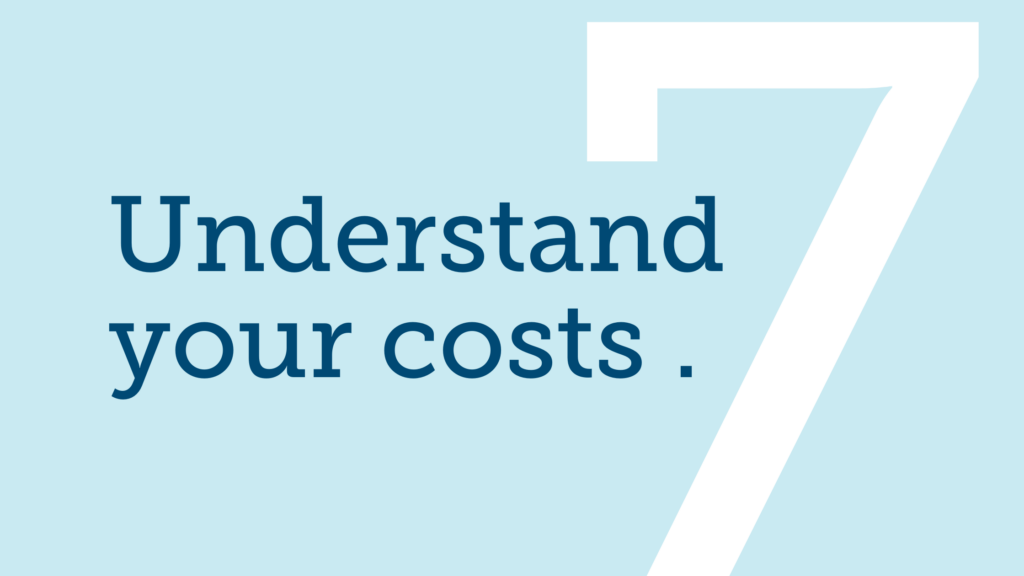This is part seven of ten in a series on foundational principles of being an entrepreneur.
Many people—who would otherwise make great entrepreneurs—shy away from business because they’re scared of numbers.
When you have a business, being “bad at math” is more than a school-age nuisance; numbers now carry great weight. They tell you if your business works–if you actually have a business.
But, we’ll let you in on a secret. When you’re starting out in business, the numbers are actually quite simple, and there are only five you need to master at the start. We’ll break it down for you.
Startup vs. Ongoing Costs
While a business ultimately needs to make money, businesses also cost money. You need to invest in equipment, a website, inventory, legal fees, utilities, bookkeeping, software, salaries, etc.
Everything that costs your business money falls into one of two categories: startup costs and ongoing costs.
Startup costs are the things you’ll need before you can open your doors or serve your first customer. For example, the filing fees for your legal entity, the buildout of your website, and the price of equipment (a mixer, a mower, a computer) are all startup costs. You have to make these investments before your business can start serving customers and you likely won’t have to keep paying for it each month.
The first number you need to know is the amount of money you need to cover your startup costs.
The next two numbers you should know fall into the other category of costs—ongoing costs. These are costs you’ll have to pay every single month. For example, salaries, software subscriptions, utilities, and raw materials are all part of your ongoing costs. You need to pay them over and over again, even after your business opens.
Fixed vs. Variable Costs
The next two numbers you need to know are two kinds of ongoing costs: your fixed costs and your variable costs.
A lot of people—understandably—get confused about what these numbers are due to their names. “Fixed” doesn’t mean the number itself is the same each month, nor does “variable” mean that the amount fluctuates.
A fixed cost is something that must be paid whether or not you sell anything. For example, if you have a retail store and not a single customer walks through the door, you still have to pay your rent, utilities (which might vary month to month), and someone to oversee the space. Those are fixed costs. You have to pay them no matter what.
A variable cost is tied to what you are selling or producing. For example, a cup of coffee has costs associated with it. There’s the cost of coffee beans, the cup, the labor to brew it, the cream and sugar, the payment processing. Each time you sell a cup of coffee, you incur these costs to produce it. The number varies because the amount you pay depends on how many items you sell. If you sell 10 cups of coffee, your variable costs are much lower than if you sell 100.
The Magic Number: Break-Even
If you have these first three numbers (startup, fixed, and variable costs), you have a starting point for figuring out whether your business can make money. But to determine that, you need to know the fourth important number: your gross profit (how much money you’ll make from each item after you cover the cost of producing that item).
Gross profit = Price – Variable Costs
For example, if the price of a cup of coffee is $2.50 and it costs you $1.50 to make it, your gross profit is $1.00.
With this number, you’re ready to find the fifth important number: your break-even point. The break-even point is the magic number because it tells you how many items you need to sell each month to cover your costs for that month. Any additional items you sell beyond that number is money you get to keep or invest back into the business some other way.
Break-Even Point = Fixed Costs ÷ Gross Profit
For example, if the fixed costs for your coffee shop were $500 a month in rent and utilities, you’d need to sell 500 cups of coffee each month to cover your costs.
What you can learn from the numbers
Five simple numbers give you the foundation needed to really know if your business will work: startup costs, fixed costs, variable costs, gross profit, and break-even point.
Startup costs tell you how much you’ll need to invest to get things up and running. You may need to pay that money up front and have a plan of where to get it.
Together, the other four numbers help you understand whether or not you actually have a business—not just an expensive hobby. To be a business, your venture has to make money.
Most likely, your first calculation may give you a break-even point that seems impossible (500 cups of coffee a month!). Don’t despair. Experiment with the numbers: raise prices or cut your costs to come up with something more realistic. The numbers can help you make choices and figure out what is actually essential for your business.
Even when you have a realistic break-even point, you might not reach that level of sales at the beginning. You can use the number to figure out how much time it will take to become fully operational—and even profitable—and what sort of gap you’ll need to cover until you get there.
The numbers help you plan. They help you prepare. They help you decide. They help you succeed.
Understand your numbers and you’ll be on the right path.
